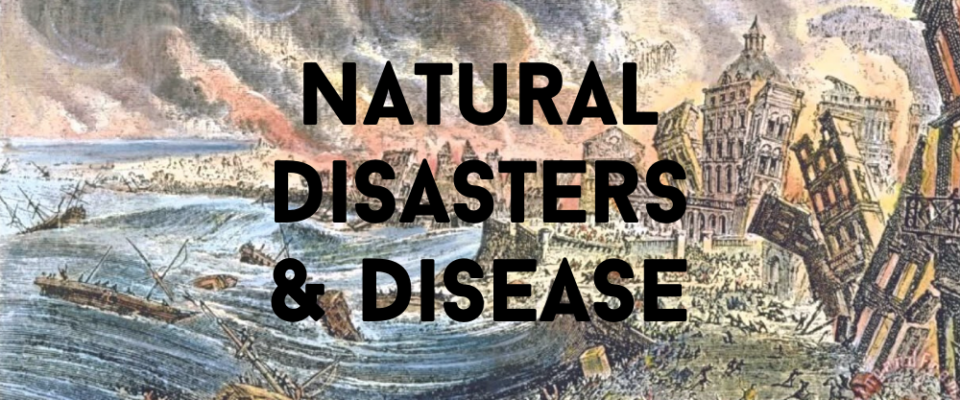By Rig Freyr
Questions
How was the city of Edo affected by the 1855 Great Ansei Earthquake? What measures were taken in response to the disaster, and what side effects did those measures have?
Discussion
This report gathers a number of sources relating to how natural disasters have historically affected the city of Edo-Tokyo, with a specific focus on the Great Ansei Earthquake of 1855. The reason I have chosen to focus on such a specific event and timeframe is that Tokyo, as the most populous city in a geologically volatile volcanic island chain, has a history of natural disasters so long as to span many volumes of discussion. For example, the 1855 Ansei Earthquake is only the most well-known of a swarm of large earthquakes that occurred throughout Japan during the early 1850s. The 1855 quake’s specificity to the Tokyo urban region, as well as the fact that it has received relatively more attention from historians in recent times, makes the event a convenient focus point for my research. However, before moving on to a discussion of my sources, I wish to emphasize that the 1855 quake is hardly the only natural disaster in Tokyo’s history that bears insights for those interested in city planning and urban theory—it is simply one of the more convenient ones to analyze.
The Great Ansei Earthquake of 1855 is called so because it occurred in the Ansei era (1854-1860), only a few years after the arrival of Commodore Perry in Tokyo Bay and the beginning of Japan’s bakumatsu period. According to Gregory Smits in his 2013 book Seismic Japan, the quake hit Tokyo suddenly on the night of November 11th (technically, “the second day of the tenth lunar month”), destroying large parts of the city and killing approximately one percent of the city’s total population (Smits 2013, 104). The primary reason that the earthquake’s destruction and associated death toll were so great was probably that, at the time, Tokyo had numerous plaster-and-tile clad structures that were resistant to fires but prone to tremors. Interestingly enough, in spite of Japan’s long history with earthquakes, as of 1855 Tokyo had not experienced a major quake for about 154 years; in the minds of the citizenry, earthquakes were either a thing of the past or simply too unlikely to reasonably plan for (Smits 2013, 103). This lack of structural preparation, combined with the fact that most of the well-populated areas of Tokyo were built on former wetlands artificially filled in with unstable alluvial soil, left the city completely undefended from the massive force of the Ansei quake (Smits 2013, 104-105). Although not much could be done to fix Tokyo’s soil base in the aftermath of the disaster, residents were able to counteract the city’s architectural deficiencies somewhat by employing more wood-based techniques (e.g. installing wooden latticework supports called doibuki instead of relying on plaster for structural reinforcement) and all but abandoning the construction of multi-story buildings (Smits 2013, 118).
Smits describes the aftermath of the Great Ansei quake in more detail in his article “Shaking up Japan: Edo Society and the 1855 Catfish Picture Prints,” published in 2006. The article focuses its discussion on the namazu-e (lit. “catfish pictures”), a genre of popular woodblock prints that arose in response to the major socio-economic shifts that swept across Tokyo in the wake of the disaster. Because catfish were traditionally associated with earthquakes in Japanese culture, namazu-e often included anthropomorphized versions of catfish performing various actions that mirrored the real-world effects of the earthquake on Tokyo’s economic and urban environment. One good example is the namazu-e piece Chousha, kane no yamai (translated by Smits as “the metal disease of millionaires”), which depicts an anthropomorphic catfish ordering a group of rich-looking men to excrete money in various ways—the picture is clearly a metaphor for the massive expenditures that many merchants and nobles were forced to make in order to rebuild their houses and estates after suffering the effects of the quake (Smits 2006, 1060-1062). The large-scale transfers of wealth from the coffers of the upper classes into the hands of craftsmen and the common folk were one of the most consistent themes in namazu-e prints, suggesting that in spite of the harm and disruption created by the Ansei earthquake, the disaster was regarded as a source of significant economic revitalization throughout the city as well (Smits 2006, 1055-1058). Overall, Smits’ point seems to be that the Great Ansei Earthquake had as much impact on Tokyo’s social landscape as it did on its physical one.
Gregory Clancey expands on Smits’ conclusions regarding the earthquake in his article “Disasters as Change Agents: Three Earthquakes and Three Japans,” by commenting on the seemingly unique perspective on the significance of natural disasters that the namazu-e and other media from the Ansei period present (Clancey 2011, 397). Clancey contrasts the unambiguously negative and mournful response to the occurrence of quakes that we see from news outlets in the modern day (e.g. the recent Tohoku earthquake and tsunami) with the ambivalent and at times celebratory view of the Ansei disaster put forth by namazu-e. In a somewhat more provocative essay “The Changing Character of Disaster Victimhood: Evidence from Japan’s ‘Great Earthquakes,’” Clancey goes on to suggest that the people of Tokyo viewed natural disasters like the 1855 quake as not being inherently negative or harmful to the city itself, but rather as a provider of opportunity and economic transformation that naturally complemented Tokyo’s growth as an urban community (Clancey 2016, 360-361). In other words, just as many urban theorists consider cities to take shape organically in relation to their natural environment, so Clancey considers the Ansei quake to have organically influenced Tokyo’s development. To the Japanese living in Edo at the time, earthquakes were thus not only something to be feared, but also to be appreciated on some level for their natural role in the city’s life cycle—however, Clancey notes that “Ansei Edo was among the last Japanese earthquakes [for which] this would be true” (Clancey 2016, 361).
Examinations of more recent responses to the impact of earthquakes and other natural disasters on Japanese urban communities seem to support Clancey’s latter assertion. As disaster and injury prevention researcher Shinji Nakahara shows in a 2011 article, Japan’s current view of earthquakes is entirely negative; the reports that he presents on the Tohoku quake and other disasters emphasize only the destruction and loss of human life they caused, with no mention of any positive aspects (Nakahara 2011, 361). Although he does not mention the 1855 Ansei earthquake itself in his discussion, Nakahara does analyze several analogous disasters from the Meiji and Taisho periods (e.g. the Meiji Sanriku Earthquake of 1896) that mirrored the Great Ansei Earthquake in their intensity. In stark contrast to the namazu-e and verbal accounts of the 1855 quake cited by Smits and Clancey, Nakahara’s data only offers information about the physical destruction created by natural disasters, as well as the sophisticated urban improvements and preventative measures developed by the Japanese in their aftermath (Nakahara 2011, 361-362). While Nakahara does not investigate the social and psychological impact of these modern disasters as deeply as Clancey does for the 1855 earthquake, it seems that at the very least modern Japanese are less ambivalent about the destructive effects of natural disasters than their Ansei forbears seem to have been.
For a concrete example, some interesting comparisons can be made between the 1855 Ansei quake and the next major earthquake to strike Tokyo and its environs: namely, the Great Kanto earthquake of 1923. Of the two disasters, the latter is the more vividly remembered by a fair margin; this is because the Kanto earthquake was more recent, was arguably more destructive (by at least one account, it leveled about 44 percent of Tokyo’s surface area), and its victims had access to black-and-white photographic technology. (Weisenfeld 2012, 17-18) As Gennifer Weisenfeld relates in her book Imaging Disaster: Tokyo and the Visual Culture of Japan’s Great Earthquake of 1923, the fact that countless photographs of Tokyo’s destruction were circulated all over Japan via newspapers in the aftermath of the 1923 earthquake shocked the Japanese populace, and caused them to react to the disaster in a notably different way from its 1855 counterpart. To be specific, the tone seen in visual media related to the 1923 quake is much less celebratory than the catfish prints of 1855; although the Great Kanto earthquake elicited just as many satirical cartoons and darkly humorous images from the Japanese visual arts community as did the Ansei quake, none of these pictorial reactions ever characterized the disaster as something to be appreciated (Weisenfeld 2012, 31-33). Weisenfeld suggests that this change in tone was brought on in part by the vividness and visual power of the various photos that brought news of Tokyo’s urban damage to the rest of the country, a new form of information dissemination that Ansei Japanese did not have access to. However, she also admits that Japan’s growing secularization and fascination with technology in the 1920s made it easier to see natural disasters as harmful obstructions of progress than as necessary parts of the natural world (Weisenfeld 2012, 50-51).
Sources
Smits, Gregory. Seismic Japan – The Long History and Continuing Legacy of the Ansei Edo Earthquake. Honolulu: University of Hawaii Press, 2013.
Smits, Gregory. “Shaking Up Japan: Edo Society and the 1855 Catfish Picture Prints.” Journal of Social History, Vol. 39, No. 4 (2006): 1045-1078.
Clancey, Gregory. “Disasters as change agents: three earthquakes and three Japans.” East Asian Science, Technology and Society, Vol. 5, No. 3 (2011): 395-402.
Clancey, Gregory. “The Changing Character of Disaster Victimhood: Evidence from Japan’s ‘Great Earthquakes.’” Critical Asian Studies, Volume 48, No. 3 (July 2016): 256-379.
Nakahara, Shinji. “Lessons learnt from the recent tsunami in Japan: necessity of epidemiological evidence to strengthen community-based preparation and emergency response plans.” Injury Prevention, Vol. 17, No. 6 (2011): 361-364.
Weisenfield, Gennifer S. Imaging Disaster: Tokyo and the Visual Culture of Japan’s Great Earthquake of 1923. Berkeley: University of California Press, c2012.
*Images from Wikimedia Commons and Flickr Fair-Use Files.






One Reply to “Disaster in Tokyo”